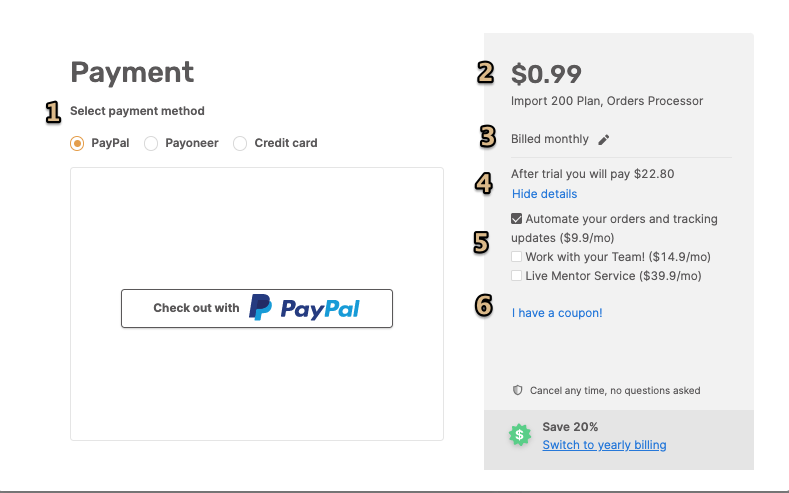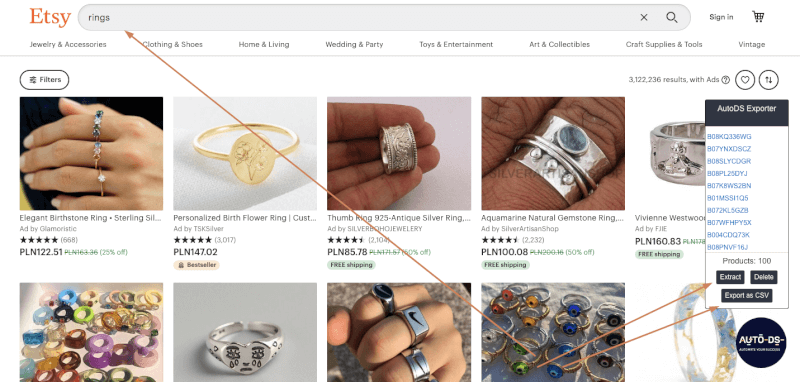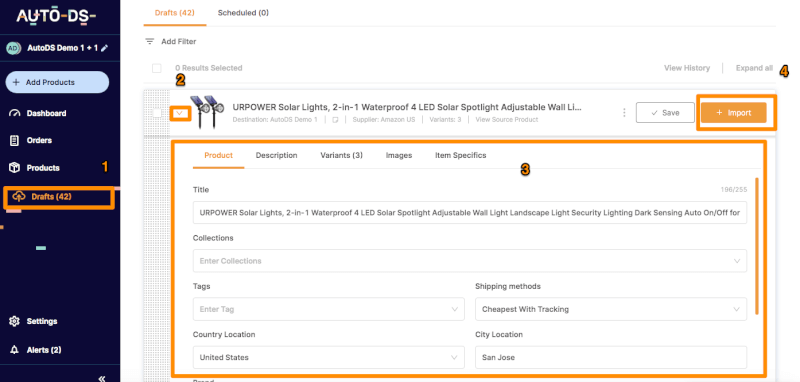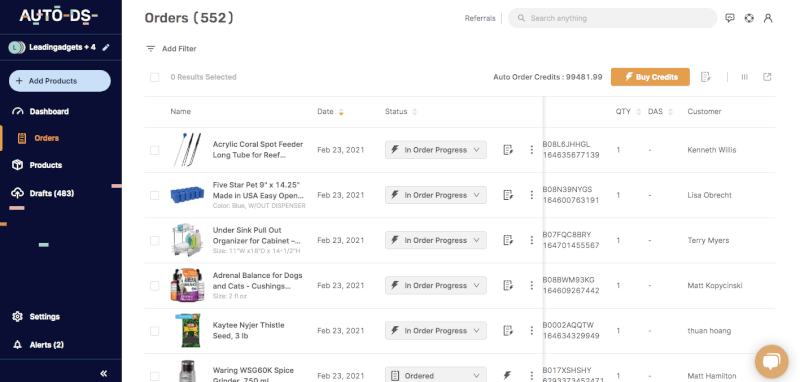The Comprehensive Guide to Dropship from Etsy to Shopify
This article delves deep into the complications of setting up a dropshipping business, specifically focusing on dropshipping products from Etsy to a Shopify storefront.
Key Takeaways
- Using Etsy and Shopify together enables the selling of unique and handmade items on a well-established platform.
- This combination offers access to niche markets with less competition and the chance to leverage Etsy’s extensive customer base.
- Effective inventory management and clear communication are vital for successful dropshipping from Etsy to Shopify
How does Dropshipping from Etsy to Shopify Work?
Dropshipping from Etsy to Shopify begins by setting up a Shopify store and selecting products from Etsy. Initially, a seller identifies unique, handmade, or niche products on Etsy. Subsequently, these products are listed on the Shopify store.
When a customer purchases a product from the Shopify store, the seller then places an order with the Etsy seller. The Etsy seller ships the product directly to the customer.

Why Combine Shopify and Etsy?
Combining the strengths of Shopify’s functionality and Etsy’s product variety can create a more diverse and attractive store, potentially drawing in more customers and increasing sales.
- Endless Niches
Etsy is known for its wide variety of unique and specialty products in different categories. This variety makes it easier for newcomers to find trending products.
- Room For Creativity
With Etsy’s array of unique products, you have the opportunity to enrich your Shopify store’s diversity. Whether you’re ready for personalized items, handcrafted toys, or other niche areas, Etsy offers various choices, guaranteeing a continuously refreshed and appealing inventory.
- High-profit Margins
The uniqueness of Etsy products often leads to higher profit margins. Due to their exclusivity, these items can demand higher prices as they’re hard to find elsewhere. Offering such unique products positions your business for enhanced profitability since consumers are typically willing to pay a premium for specialty items.
- Established Customer Base
Etsy’s extensive and dedicated customer base can provide a substantial advantage to your dropshipping venture. The platform’s trusted reputation means many consumers favor buying from Etsy sellers over lesser-known e-commerce stores.
- Outshine your Competitors
Showcasing unique items sets you apart from the competition. Unlike platforms such as Amazon or AliExpress, Etsy is renowned for its distinctive offerings. This ensures you offer products that are truly one-of-a-kind and unavailable on other marketplaces.
What you can dropship from Etsy to Shopify?
You can dropship various unique items from Etsy to Shopify, including handmade goods, vintage items, and crafting materials.
You can check out Etsy’s Prohibited Items Policy for more details.
Handmade Items
Handmade items are made or designed by you – the seller.

If you sell handmade items, you need to:
- Physically create or originate the designs for your items
- List all individual items involved in creating your products or managing your business in the “About” section of your shop. For items created with a production partner, disclose this collaboration in the relevant listings.
- Use your own photographs for product listings
Vintage Items

Items in this category must be at least 20 years old. Products under this age or those merely styled as vintage don’t qualify. Additionally, Etsy requires sellers to provide documentation verifying the item’s age or authenticity.
Craft Supplies
On Etsy, craft supplies are tools, ingredients, or materials designed mainly for crafting or special occasions. These suppliers can range from handmade to commercial or vintage items. Additionally, party supplies fall under the craft supplies category.

Digital Items
On Etsy, digital items are downloadable files available for purchase. Just like handmade offerings, these digital products are created by the seller. They can be pre-made files or custom files delivered to the buyer post-purchase.
Prohibited Items
Some types of items are prohibited from being sold on Etsy, including

- Alcohol, tobacco, and drugs (including drug paraphernalia and medical drugs)
- Certain animal products and human remains
- Dangerous items: hazardous materials, recalled items, and weapons
- Hate items: those promoting, supporting, or glorifying hatred
- Illegal and highly regulated items, as well as those promoting illegal activities
- Internationally regulated items
- Pornography and mature content
- Violent items: those promoting, supporting, or glorifying violence.
How to dropship from Etsy to Shopify using AutoDS
Though it has multiple steps, the dropshipping process from Etsy to Shopify is straightforward. With proper guidance, navigating its learning curve becomes easier.
Step 1: Find a supplier on Etsy
The first step is to begin with finding a supplier. By simply searching “dropship” or “dropshipping” in Etsy’s search bar, you can easily find a potential supplier.
Once you’ve identified a supplier, it’s essential to establish direct communication. Engaging in a conversation about their willingness to dropship, alongside other critical aspects like shipping times, pricing, and return policies, sets the stage for a seamless partnership ahead.
Here are some tips to find a trusted dropshipping supplier on Etsy:
- Keyword Search: Start by typing keywords related to your desired products in Etsy’s search bar. If you’re interested in dropshipping, try keywords like “dropship” or “wholesale.”
- Refine Search Results: Use the filters on Etsy to narrow down search results by location, price range, item type, or shipping options. This will help you focus on suppliers that fit your needs.
- Examine Shop Ratings and Reviews: Before approaching a potential supplier, check their shop ratings and read reviews from other buyers. This will give you insights into the supplier’s reliability and product quality.
- Review Product Listings: Pay close attention to product descriptions, images, and prices. Check for details about bulk orders or wholesale pricing if that’s what you’re interested in.
- Ask About Custom Orders: If you have specific product ideas in mind, inquire if the seller takes custom orders. This can open up possibilities for unique products tailored to your needs.
- Check Turnaround Times: If you’re considering dropshipping, ask about the typical production and shipping times, especially if you’re dealing with handmade products.
- Discuss Pricing: If you’re looking for a long-term partnership or bulk purchases, negotiate prices or ask about discounts.
Step 2: Create a Shopify store
After identifying your dropshipping supplier, the next step is to set up your Shopify store if you haven’t already. Begin by signing up for a Shopify free trial, select a Shopify plan for 1$ per month for the first three months, and start listing your Etsy products on your Shopify store.
When listing products, ensure they have concise titles, detailed descriptions, and corresponding images to provide potential buyers with comprehensive information.
Step 3: Create your AutoDS Account
- To start, you go to www.autods.com and click on “Start Now For $1”.

- Enter your mail: You can register using an email address or through a Gmail login. However, if you opt for the Gmail login, you cannot change the login email later on.
- Enter your details and click “Continue”:

- Enter your full name and password and click “Continue”:

- Choose your selling channel – Shopify and then click “Continue”.

- Now you have to choose your payment method and your monthly/yearly plan
Please check the featured numbers in this image, you will find a detailed description of each featured number underneath the image.

- Select payment method: You have the option to pay via PayPal, Payoneer, or a credit card. If you opt for PayPal or Payoneer, you’ll be redirected to their platform for recurring subscription payments. Once approved, you’ll be back to AutoDS. For credit card payments, ensure you enter all required details accurately before proceeding and click “Continue”.
- Plan and add-ons: You see the package and add-ons you selected. If this is the first time registering to AutoDS you have to pay the first $0.99 for the plan you choose, and after 14 days you will pay the full price for the selected plan.
- Billed monthly/yearly: Click on the little pencil to change the plan from a monthly to a yearly plan.

- After trial payment: You will be charged for both the plan and any add-ons after the trial period ends.
- Add-ons: Choose the add-ons that are important and relevant to your business.
Automation: Add our order automation feature for just $9.9 per month to save time on order processing.
Mentoring program: Enroll for $39.9 per month and receive personalized guidance from our experienced mentors. They will assist you with diverse strategies and tactics and address all your dropshipping questions.
Coupon: If you have a coupon, click “I have a coupon” to add your coupon code.
- Click on “Continue” to payments and complete the registration process.

Step 4: Link your Shopify Store with AutoDS
After setting up your AutoDS account, navigate to the top left menu to add your Shopify store. Simply add your store’s URL and follow the straightforward instructions. Within a few steps, your Shopify store will be linked to AutoDS.

Step 5: Find Products To Sell and Create Drafts
You need to create product drafts to import.
Go to Etsy.com and use AutoDS Helper Extension to import all products through a click of a button.

Step 6: Optimize & Prepare Your Products
After importing, your products will be listed on your drafts page, allowing for easy optimization. Change the title, and description, edit variations, refine images, and set the right price.
Once done, click “Import” to add it straight to your Shopify store or schedule it for a later date and time.

Step 7: Monitor Price & Stock
AutoDS’ monitoring system continuously scans products from supported suppliers, ensuring your Shopify store stays updated with any price or stock changes. Additionally, it factors in shipping costs, automatically reflecting them in your store’s final product price.

Step 8: Automate Your Order Fulfillment
Congratulations! Automate your Home Depot orders by using the AutoDS Fulfillment Service. By adding a balance, we’ll handle all order processing, as well as any returns or cancellations, from our accounts.
Dropshipping from Etsy to Shopify: Costs Breakdown
Here’s a cost breakdown of dropshipping from Etsy to Shopify
| COST TYPE | ESTIMATED COSTS |
| Etsy Costs | |
| Listing Fees | $0.20 per item listed |
| Transaction Fees | 6. 5% of the sale price (including shipping) |
| Payment Processing Fees | 3% + $0.25 per sale (for Etsy Payments) |
| Shopify Costs | |
| Monthly Subscription | Starting at $39/month |
| Transaction Fees | 0.5% to 2.0% (if not using Shopify Payments) |
| Credit Card Processing Fees | 2.4% – 2.9% plus a flat 30¢ transaction fee |
| App/Tool Costs for Integration | $5 to $50/month or more (depends on the app/tool) |
| Product Costs | Varies (depending on the product & agreement with the Etsy seller) |
| Shipping Costs | Varies (based on Etsy seller’s rates) |
| Potential Return Costs | Varies (based on return shipping or restocking fees) |
| Marketing and Advertising | Varies (based on your advertising strategy) |
Dropshipping from Etsy to Shopify: Challenges & Solutions
Dropshipping offers significant potential, but it also presents challenges, particularly for Shopify store owners. Let’s delve deeper into the intricacies of this business model, several pain points emerge:

Inventory Management
- Problem
One significant challenge with dropshipping from Etsy to Shopify is inventory management. Since numerous Etsy products are uniquely crafted or available in limited batches, there’s a high risk of products running out of stock.
- Solution:
To mitigate this issue, it’s essential to maintain open communication with Etsy sellers about product availability. Using inventory monitoring tools or hands-on approaches helps store owners keep updated on stock levels and prevent potential overselling.
Longer Production and Shipping Time
- Problem:
Handling handmade items on platforms like Etsy presents a challenge due to the extended crafting time they demand. These products often require more time to craft, leading to prolonged production periods.
- Solution:
To tackle this challenge, sellers should emphasize transparency early on. By clearly communicating production and shipping durations during the purchasing phase, customers can set realistic expectations. This forward-thinking strategy enhances customer trust and minimizes potential frustrations.
Quality Control
- Problem
A prevailing problem is the inability to inspect products, leading to potential quality discrepancies. As sellers don’t have firsthand access to the items, there’s an inherent risk of delivering a product that doesn’t meet customers’ expectations.
- Solution
Addressing this challenge requires proactive measures. Regularly gathering customer feedback can identify persistent quality issues.
Additionally, by ordering product samples for personal review, sellers can bolster quality assurance, ensuring products meet the desired standards.
Communication Gaps
- Problem
For Shopify store owners partnering with Etsy sellers, effective communication is vital. The interaction between the customer, store owner, and Etsy seller can lead to misunderstandings. Therefore, setting clear communication channels and protocols is crucial.
- Solution
To overcome communication barriers, establish a strong order tracking and management system. Maintaining consistent communication with both the customer and the Etsy seller can streamline order fulfillment and enhance trust and transparency.
Return & Refund Challenges
- Problem
Handling returns in dropshipping, especially when sourcing from Etsy, can be complex due to the varying policies of individual Etsy sellers. This disparity can lead to confusion and inconsistencies in addressing customer return requests, making the process more complex than standard retail returns.
- Solution
To streamline the return process, you need to collaborate with the Etsy seller to create a cohesive return and refund policy. After completing the policy, clearly convey it to your customers to prevent misunderstandings and enhance their trust.
Price Competition
- Problem
Competing on price can be a significant challenge for sellers. Because of additional costs, items on your platform might be priced higher than on Etsy or comparable sites. This can make it difficult to attract customers when they discover the same products at lower prices elsewhere.
- Solution:
To address this issue, underscore your store’s unique advantages. Emphasizing the unique value proposition, such as product curation, customer service, or other unique selling points, can make a difference.
Furthermore, bundling products or providing additional value-added services can also offer compelling reasons for customers to choose your store over more affordable options.
Platform Policy Issues
- Problem
In e-commerce, platforms like Etsy or Shopify can change their terms or policies without warning. This ever-present risk means that what is a feasible business model today.
- Solution
To stay safe from sudden changes, it’s crucial to remain informed about platform updates and maintain flexibility. Additionally, diversifying product sources can diminish dependence on one platform, providing a safety net against unforeseen changes.
Shopify Etsy Dropshipping: FAQs
- Choose a Dropshipping Supplier: Research and select a reputable dropshipping supplier. Popular options include AliExpress and SaleHoo.
- Set Up an Account: Once you’ve chosen a supplier, sign up for an account with them.
- Install a Dropshipping App: Go to the Shopify App Store and install a dropshipping app compatible with your supplier, like the DPL app for AliExpress.
- Connect Your Store: Link your Shopify store to the dropshipping app.
- Import Products: Using the dropshipping app, browse products from your supplier and select those you want to sell. Click to import them directly into your Shopify store.
- Set Pricing and Product Details: Once products are imported, adjust their prices, descriptions, and images as needed.
- Launch & Monitor: After setting up, launch your store, and monitor sales and inventory levels regularly.
- Always remember to familiarize yourself with Shopify’s guidelines and the terms of your chosen dropshipping supplier to ensure smooth operations.
In Conclusion
Dropshipping between Shopify and Etsy offers entrepreneurs a distinctive advantage by combining Etsy’s unique handmade offerings with Shopify’s powerful e-commerce tools. This synergy allows sellers to establish a tailored and customer-focused online shopping experience.





